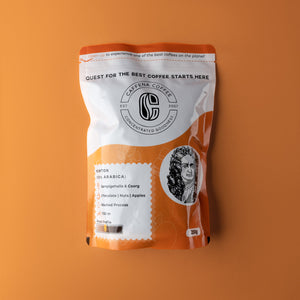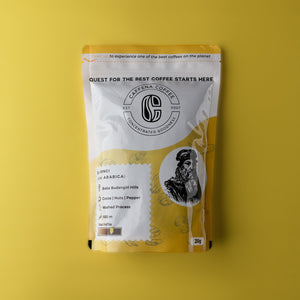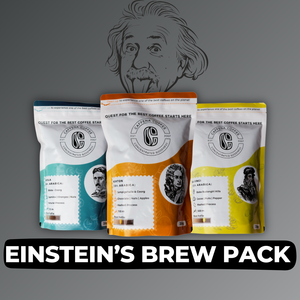The Challenge
After reviewing many articles on Robusta, we realized that most content on it could be classified as appreciation posts for Arabica. So we decided to shake up the conversation with our article on Robusta Coffee. We are taking up the challenge to prepare a long-form report on Robusta by limiting the use of the word "Arabica" to no more than ten words.
Introduction
In the world of speciality coffee, the name Arabica has outshone most other varieties of coffee. It is estimated that Robusta is the second most-produced coffee type in the world with its yields making up as much as 39% of the world’s coffee cultivation. And yet, you might have seen the words ‘100% Arabica’ written on most coffee sold as a short-hand of great quality, but the search for Robusta coffee doesn’t yield much.
So where does all this Robusta coffee go? Where is it used? And what does it get for being in second place in the world's coffee race? In this article, we shall explore the unsung tale of Robusta Coffee. Upon more research, we found that the Black Sheep of the coffee family has a strong argument going for it. This coffee plays a crucial role in our daily coffee consumption without us knowing. It is the variety used in most instant coffees and also used to create blends by cafes to add a punch of coffee in their milk-based drinks and frappes!
These two coffees don't just have different characteristics in the cup – they have additional packaging requirements, too. Robusta beans tend to have higher levels of sucrose and carbohydrates, which means they also degas quicker. Now let's dive right in and explore the story of Robusta and where it stands today!
Why did people start drinking Robusta?
Robusta coffee originates from Central and Western Sub-Saharan Africa. If you remember from our last article on Arabica (If not, click here to check it out), we discussed how it was widely grown worldwide by the Dutch and the British, especially in East Asian countries. And how, due to a 98% genetic similarity in most varietals, it was decimated by The Coffee Rust disease, which wiped out coffee production resulting in virtually zero yields. Also known as the Ceylon Epidemic of 1869, which left the British to take drastic steps and turn to tea as an alternative.
The world loved coffee, and they got completely blown away by the effects the beverage had on the masses. It left researchers and farmers looking for an alternative way to grow coffee to overcome the risks of such epidemics. They were pleased to find that the answer lies in Coffea Canephora of Congo, which came to be known as Robusta. It was much more resilient to climate changes, diseases, and even pests. This coffee had more earthy flavors and a higher caffeine concentration while producing a much higher yield than other family members.
High-quality Robusta coffee beans make more vital espresso shots with earthy undertones, and its blends work very well with immersion brews like French press and are best enjoyed with a dash of milk.
Today, the addition of Robusta to blends is now a widely accepted practice in the specialty coffee industry. Not only does it lower costs, but it can also add to its quality, complexity, and depth while creating a more well-rounded drink.
Robusta as a part of the Global Coffee Culture
Robusta coffee is usually cultivated at lower altitudes, from 0 to 600 meters above sea level, in humid and warm climates. These ecosystems exist in the world's equatorial regions, namely Vietnam, west Africa and Indonesia. Vietnam is the biggest producer in the world. And axiomatically, Robusta also happens to be the staple coffee consumed. This has given birth to some iconic coffee beverages which are enjoyed around the world, like Vietnamese coffee, which uses the concentrate from an immersion-style drip brew and condensed milk. Best enjoyed iced. Some also choose to replace the concentrate with a cold brew. This drink can be traced back to the French influence on Vietnam, as they were the first colonizers to introduce coffee plantations in the country.
Robusta is so deeply rooted in Vietnamese culture that Starbucks failed to make any wind in Vietnam for the longest time. This was due to their Arabica-centric focus.
If we dive deeper into the conditions which Robusta needs, we find that Robusta's suitable climates give way to many more regions of the world to grow coffee with ease. These plants also resist diseases like coffee rust and pests due to their high caffeine concentration. This makes it a viable option for production. This can help us tackle the ever-increasing prices of Arabica, mainly influenced by a dwindling supply and shrinking suitable land, which makes it a commodity that sells at a premium.
Even after a meteoric rise, its prices are expected to creep upward as they progress. This is based on predictions that call for a 50% drop in our ability to produce Arabica by 2050. All these factors predict that Robusta production will rise due to its "robust" nature.
We know that cultivators can move crops to higher ground or use fungicides on a bigger scale to help the plantation, but the land is still scarce, and fungicides are expensive. With Robusta plantations, you need fewer resources combined with a higher yield and environmental stability because of its suitability, making it a good choice for cultivation.
What’s next for Robusta?
Arabica coffee quickly became the star child of the speciality coffee world. This is mainly credited to its diverse fruity flavour profile.
Keep in mind that Arabica has been around for much longer, which is why more research has gone into improving its quality. Higher-quality Robusta is still used in espresso because of its crema in the brew. However, there is a solid case to be made that there is still much potential to explore.
Unfortunately, since the beginning, Robusta has been seen as "inferior" due to its larger yield and lower market price. This is why researchers have swayed off the topic of Robusta, and little effort has been made to improve the production and cupping methods that involve Robusta.
Good quality Robusta beans have a higher acidity, lesser bitterness and a palatable earthy/nutty flavour profile. Good quality Robusta is defined by its origin, the fermentation process involved and its roasting method, which determines the notes it retains.
The name Robusta itself means robust, but it does not have to mean bad. If higher quality Robusta yield could be produced, it would raise the market price as well, leaving more initiative for farmers to create even more Robusta, and in the end, we would have better-tasting coffee with a great diversity of flavor profiles and overall better quality than what we see in the general communal bashing.
Yet in recent years, more and more "specialty" robustas have entered the market. This has been helped along in no small part by the Coffee Quality Institute (CQI), which introduced its pioneering Q Robusta Program in 2010.
The program aims to create a common language of quality around specialty robusta. Part of this involves the CQI protocol, which means Robusta can only be considered a specialty if it meets a specific set of standards. These include no more than five secondary defects and a final cup score of over 80 points.
Conclusion
The greater focus on Robusta and its potential has led several roasters to offer it as a single alternative origin. For example, we are seeing single-origin Robusta coming in from countries such as Mexico, which, paired with lighter roasting practices, will allow Robusta to create its diverse range of flavor profiles as we progress through.
This has prepared the coffee industry to pave the way forward for Robusta, and as things are looking, we wouldn't be surprised to see Robusta rise through the coffee leader-board in the coming years. Not just in terms of production levels but also quality.
What do you think? If you would like to explore the nuances of some high-grade robusta, you can check out our House Blends here. And as always, we have a unique bonus code for our patrons who made it here. Use the code ROBUSTA101 to avail a 10% discount on our house blends and enamel mug!





